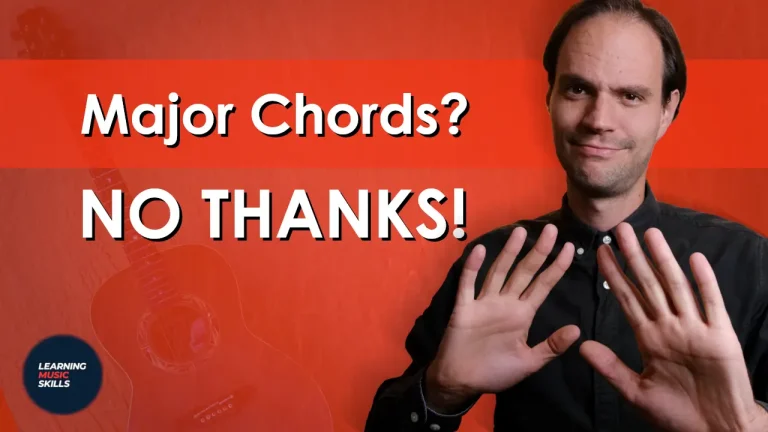Struggling with boring chord progressions? Or do your progressions sound too happy and not emotional enough? Then the technique of chord substitution will be perfect for you. You can use the relative minor of a major. And it sounds especially good if it is a minor in first inversion chord. Let’s get creative!

We’ve all been there. You are not satisfied with your chord progression. It’s not that the whole progression is bad but it does need a small fix. In this case, chord substitution is what you need. Easy chord subs that you can use are the relative minor of a major and the relative major of a minor chord.
This is what you will learn from this article:
You can also see this lesson’s technique in action in my episode about the perfect soundtrack made by Sufjan Stevens. In this beautiful song, he uses minor chords in first inversion to replace major chords. This is a smart way to create variations and a more emotional sound.

Video Tutorial: Major Chord Substitution
If you want to hear how the relative minor of a major sounds in action check out this video. It is the
What Are Chord Inversions?
Every regular chord or triad is made out of three notes.
- The root note
- The minor or major third
- The perfect fifth
Normally the root note is also the lowest. This means that the note name of the chord is in the bass. But this is not the case when a chord is in the first or second inversion. When a chord is in first inversion, then the 3rd is the lowest. And with the second inversion, the 5th is the lowest.
Chord inversions sound different from root position chords. They are great for creating variation in your chord progressions. Also, they are often used to allow smoother or better voice leading. Just play the root position and first inversion chords to hear how different they sound!


What Are Relative Or Mediant Chords?
Relative and mediant chords are closely related but are two different things. Let’s start with relative chords. There are two types of relative chords.
- Relative major chord
- Relative minor chord
Relative chords
Below are the harmonies of C major. You can find the relative minor of a major chord by looking at the chord a minor third below it. So you can see that the relative minor for C major is A minor. Also, for example, the relative minor for G major is E minor.
When you want to find the relative major of a minor chord then you do the exact opposite. You look at the major chord a minor third above it. So for example the relative major for A minor is C major. The relative major for E minor is G major.

The term relative minor or relative major is also often used for modulating. For example, when a piece is in the key of C major. During the verse, C major is the tonic chord but in the bridge, A minor is your tonic chord or home base.
Diatonic mediant chords
Diatonic mediant chords are chords that are a third apart from each other. Below or above. This can be a minor or a major third. The word diatonic means, that all chords are in the same key. They all use notes from the same scale. For example, below all the chords are from the key of A major. You make them from the notes of the A major scale.
When you look at the harmonies below, you can see that the mediant chords of D major are Bm and F#m. And to clarify the difference the D major relative minor is B minor. Either the Bm key or chord. The mediant chords of C#m are E major and A major.

How are relative chords different from mediant chords? The term relative chord is about more than just the chord. It’s about what you see as the major or minor key. The question is what is the relative minor of a major and what is the relative major of a minor? So that’s why the relative minor for C major can only be A minor. Or the relative minor for A major is F#m.
How To Use Relative Chord Substitution
What it all boils down to is that you replace a major chord with a minor chord. But there are two things that you need to keep in mind.
- The minor chord needs to be in the first inversion
- The minor chord needs to be the relative minor of the major chord
Look at the chord progressions below. Here the D chord substitute is B minor in the first inversion. It is a D chord alternative that sounds more minor and emotional.


If you have a chord progression where you need an F chord alternative, then the D minor first inversion chord is the best option. Just like our chord progression above it is a more emotional and complex option. The D minor in the first inversion is a perfect F chord substitute for when you need something that sounds more ambiguous and colourful.

For example, if you need a G chord alternative, then the E minor in the first inversion is a great option.

Conclusion and Summary
This major chord substitution technique is for when you want to add extra colour. When something is missing and your chord progression sounds too basic. So see if you can replace any major chords with a relative minor chord in the first inversion.
Just remember that the chord needs to be the relative minor and that you use it in first inversion. Then the chord sub will sound most natural. Because this also makes sure that your bass note stays the same.






